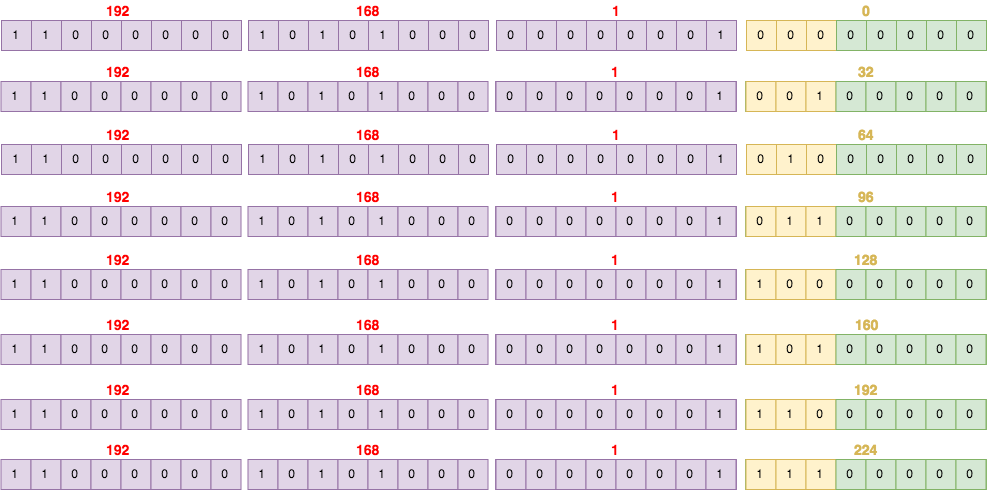Estimated difficulty: 💜💜💜🤍🤍
Every time I attend a course and someone tries to explain subnetting to me, they pretty much un-teach me it and I have to go away and re-learn how it works. To keep this post short and simple, I’m just going to cover how subnetting works, and not delve much into other networking concepts.
So firstly, a subnet is a small unit of a network (subnetwork, if it helps) – we pretty much want to carve a network up into smaller blocks to make it easier to route packets, transmit data, troubleshoot issues, build in a bit of resilience, or separate assets for security reasons and so on. A common analogy for this is to think of IP addresses and subnets in the same way you would as a physical address or a postcode (ZIP code in the US). Here’s a fake address (broken down into four parts so you can see the parallel) as an example:
House number: 102
Street name: Terrick Road
Town: Elmley Castle
Postcode: WR10 0TJPostcodes nowadays can usually pinpoint the street or building, so all you really need is the house or apartment number, but basically, a subnet is just a way to logically separate an IP (Internet Protocol) network in this same way.
IP Addressing
In case you’re not totally familiar with IP addressing, IPv4 addresses consist of four binary octets (bytes). (If you don’t understand binary and want to read more about it, I wrote this a little while ago.) To make them easier for humans to read, we represent them in denary (decimal), with separators like this:
Binary: 00000110000001100000011000000110
Denary: 10.10.10.10This shows you how they’re broken down:

IPv4
There are five classes of IPv4 addresses, for the purposes of this post we’ll focus on the most common – classes A, B and C.
| Class | IP Range | Use |
| Class A | 1.0.0.1 – 126.255.255.254 | 127 networks with up to 16 million hosts each |
| Class B | 128.1.0.1 – 191.255.255.254 | 16000 networks with up to 65000 hosts each |
| Class C | 192.0.1.1. – 223.255.254.254 | 2 million networks with up to 254* hosts each |
*As a side note, a number of IP addresses on a network can’t be assigned to hosts because they’re reserved for other purposes – there’s usually a network IP and a broadcast IP (e.g. x.x.x.0 – the network number/IP, and the final IP in the range e.g. x.x.x.255 – which will broadcast to every other host in that IP range). This is why even though theoretically a network could support up to 256 hosts, the number of usable IP addresses is less.
At a simple level, for Class A, the first octet is reserved for the network address, and the next three octets are host addresses. For Class B, the first two octets are reserved for the network address, and the third and fourth octet are the host addresses. For Class C, the first three octets refer to the network address, and the final octet refers to the host addresses.
Subnetting IPv4
If we stick to these conventions, the structure of IPv4 is quite inefficient because of the rigidity of network/host splits in addresses – if you only need 50 hosts on a network (or a portion of a network), you’d be wasting about 200 IP addresses on a standard Class C network. So we divide these networks into subnets, by splitting out the last octet into subnets and host IDs.
For 50 hosts, we’d only need 6 bits of the last octet for host IPs – which frees up 2 bits of the octet and allows us to create 4 subnets, which can each support up to 62 hosts (64 minus the network and broadcast addresses).
| 1 | 1 | 0 | 0 | 0 | 0 | 0 | 0 | 1 | 0 | 1 | 0 | 1 | 0 | 0 | 0 | 0 | 0 | 0 | 0 | 0 | 0 | 0 | 1 | 0 | 1 | 0 | 0 | 0 | 0 | 0 | 0 |
The problem with this is that by default a computer will try to read all 8 bits of the last octet as a host address, so we need a subnet mask to tell the computer that we’ve used 2 bits of the host octet for a subnet.
The subnet mask for a subnet of this size would be 255.255.255.192 – we’re basically feeding in a note to say; “We’re using these bits for the network address” – and 256 (total addresses) – 192 (the final part of the subnet mask) = 64 (total addresses, including network and broadcast addresses).
CIDR (Classless Inter-Domain Routing) notation for this is /26 – which shows that the first 26 bits of the 32-bit IP are reserved for the network address, and the final 6 are used for the host IP’s.
Here’s a cheat sheet (kindly provided by ZephrFish) to show you some examples.
IP addressing is about 40 years old – IPv4 was formally standardised in 1981, and because of the structure the maximum number of IPv4 addresses available globally is just under 4.3 billion. That sounds like a lot, but think about how many more devices than people there now are in the world – you won’t be surprised that 4.3 billion IP’s hasn’t been enough. This is where IPv6 comes in (1998) – we’ll cover this in a separate post, in the interest of keeping this one a sub-5 minute read.
Subnetting can be quite difficult to get your head around, so if this explanation didn’t help – I quite liked this reddit thread, and this article on iTT Systems might be helpful for an explanation of IPv4.
Thank you for reading!
Morgan x